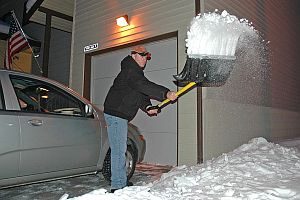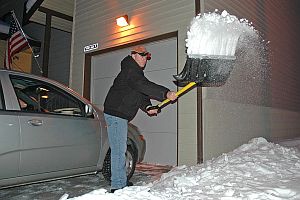How to Reduce the Risk of Snow Shoveling Injuries

When the snow starts to fly, your trusty shovel is often the only thing between you and a day spent snowed in. If used improperly, however, that same shovel could leave you with a painful (and maybe even debilitating) injury. Statistics from emergency room and primary care visits provide plenty of evidence that it happens to lots of people every year. That said, it is certainly possible to remove snow from your sidewalk and driveway safely. Here are a few techniques that will help you reduce your risk of snow shoveling injuries.
How to Reduce Your Risk of Snow Shoveling Injuries
The first thing to do when facing the cold is to make sure your body is nice and warm – warmed up, that is. Snow shoveling is an aerobic activity, so it’s wise to treat it the same way you would a jog or a swim. Walk briskly for five minutes, do 100 jumping jacks, or simply march in place. Stretch your lower back, hamstrings, and arms to make sure they’re limber and flexible. Your chiropractor can show you specific stretches that will help get your muscles and joints in shoveling shape.
Next, consider your tools. Having the right ergonomic shovel is a great help when it comes to removing stress on the spine. Choose a shovel that has a curved handle for better ergonomics. A shovel with a small, plastic blade limits the amount of weight you’ll end up lifting, reducing the risk of strain and injuries. Choose your clothing carefully as well. Good quality boots with plenty of traction will keep your feet warm and dry while reducing the risk of slipping.
Once you’re prepared, it’s time to shovel. Push the snow to the side rather than lifting it whenever possible. When you do have to lift, the key word is “straight.” Face the snow straight on, with your hips square. Bend at the knees, take on a small load, and lift with your legs while tightening your stomach muscles. Keep your back straight: don’t twist to toss the snow to the side. Instead, move your feet.
Proper pacing is another effective way to avoid injuries. If you are dealing with a foot of snow, don’t try to get all of it in a single scoop. Instead, remove it in layers from the top a few inches at a time. Take a break every fifteen minutes, or if you start to feel overworked. Stretch your arms, switch out your gloves or hat if they’ve gotten soaked, and remember to drink plenty of water.
The number one way to avoid shoveling injuries is to let something (or someone) else do the work. A snow blower is a great investment if you live in a snowy area or have lots of ground to cover. If you suffer from back pain or have a previous injury, consider hiring someone else to do the job.
If you tend to have back pain after shoveling, consider checking in with a chiropractor about it. Your chiropractor can help you identify areas where your technique could be changed for better safety and effectiveness. He or she can also suggest specific exercises and stretches that will improve your core strength and flexibility. With a little caution and know-how, you and your shovel can handle any winter challenge that comes your way.
